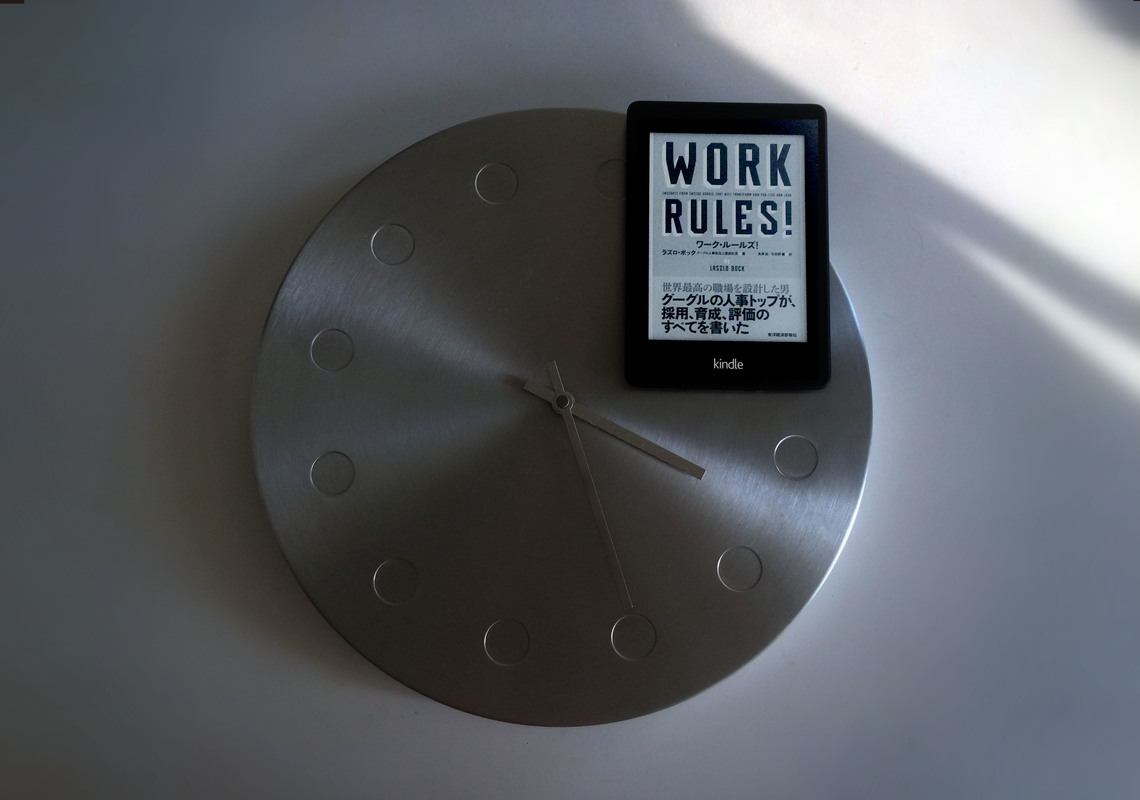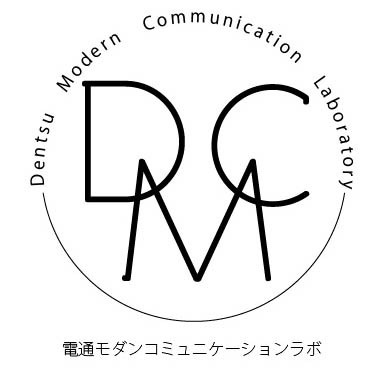今回は『ワーク・ルールズ!−君の生き方とリーダーシップを変える』(東洋経済新聞社)を紹介します。著者のラズロ・ボック氏はGoogleのピープル・オペレーションズ(人事)担当上級副社長で、世界40カ国以上のオフィスで働く5万人以上の「グーグラー」を束ねる人事部門トップ。彼がGoogleの社員採用、成果評価、モチベーション維持の方法について、つまびらかに書いたのが本書です。つまびらかすぎて書籍版は560ページとかなりのボリュームに…。本稿ではこの大ボリュームの中から、特に面白く感じた点をいくつか紹介します。(補足:腰痛持ちの私は質量0のキンドル版を購入しました)

データ分析とコミュニケーション・デザインと効果検証
すべての「ソリューション」に対していえてしまうことかもしれませんが、Googleの人事に対するアプローチも
①データ分析
②課題解決・行動変容を促すための(コミュニケーションの)設計
③効果検証
の3つのステップで構成され、しかもそれが徹底しています。
Googleのピープル・オペレーションズにはアナリティクスグループがあり、すべての人事データを統合・分析し、現状を把握しています。そこから発見された課題を解決するため、対象の行動変容を促すような仕組みを検討し、実践します。多くの場合は、小規模なサンプルでテストし、成果が出れば正式に導入、という手順を踏みます。もちろん、導入後も効果検証は欠かしません。…つまり(その突き詰め具合さえいったん脇に置いておけば)普段の私たちの仕事と同じ!といえるのではないでしょうか。本書は人事領域に限らず、このような視点で見ても豊富な事例集となっています。
採用面接時には直感を信じてはいけない
例えば、採用面接。最初の極めて短い時間で対象者を採りたいかどうか、直感的に判断していませんか?(私は、大いに心当たりがあります…)
本書では、面接の結果は最初の10秒で下された判断から予測できる、という研究結果が紹介されています。逆に言えば、通常の面接では、最初の10秒でもたらされる印象以上のことは分からないということです。マズイです。それではただの第一印象です。充分に対象者を評価できているとはいえません。さて、Googleではどうしているのでしょうか。
Googleが手がけたものではありませんが、面接対象者の職務能力をさまざまなテストがどれだけ判断できるかについての研究で、以下のようなスコアが出ているそうです。
非構造的面接(通常の面接)14%
職務経験年数 3%
身元照会 7%
筆跡による能力解析 0.04%
ワークサンプルテスト 29%
一般認識能力テスト 26%
構造的面接 26%
誠実性評価 10%
通常の面接(非構造的面接)より精度が高い手法がいくつかあります。これらの評価手法は組み合わせることで予測精度が上がることも分かっているので、Googleでは 構造的面接×一般認識能力テスト×誠実性評価×リーダーシップ評価×ワークサンプルテスト のように、組み合わせて使用します。聞きなれない「構造的面接」ですが、これは、質問や手順が評価基準と共にあらかじめ決められた面接方法で、評価手法としては非常に優れているものの、運用に手間がかかります。そこでGoogleでは、各面接の条件に応じて質問事項が自動で設計・配信されるシステムを開発し、面接者がスムーズかつミスなく面接を行えるようにしました。
その一方で、いわゆるフェルミ推定的な難問奇問(「マンハッタンにガソリンスタンドがいくつあるか当ててください」といった類のもの)もかつては実施していたようですが、「訓練すれば改善できる個別のスキルが測れるくらいで、受験者の評価の役に立たない」とバッサリ。現在では見直しが図られています。
健康と富と幸福に導くナッジ
行動経済学に「ナッジ(nudge)」という概念があります。これは、「選択肢を排除せず、経済的なインセンティブを大きく変えることもなく、人々の行動を予測可能な形で変える選択的アーキテクチャの要素」と定義されています。Googleでは「オプティマイズ・ユア・ライフ(毎日を最適化する)」と称して、このナッジを利用して、社員が健康と富をより高められるように社員の意思決定に介入しています。
Googleがカフェテリアで食事を無料提供していることは有名ですが、ここでも社員を健康にするためにさまざまなアプローチが試されています。
1)食べ物について好ましい選択をするような情報を提示する:健康に良いものに緑のラベル、悪いものに赤のラベルをそれぞれ貼る。
【結果】☓ 色分けすること自体は社員に好評だが、実際の消費量は変化しない。
2)選択肢を健康的なものに絞る:毎週月曜は肉を出さない「ミートレス・マンデー」に。
【結果】☓ あまり効果なし。その上、一部社員から肉という選択肢が減らされたことに対する抗議行動が起こる。
3)選択を制限することなく、環境の構造を微妙に変える(=ナッジ):カウンターの目につくところに健康的な菓子を置き、甘くて不健康な菓子は不透明な容器に入れ棚の下のほうに置く(中身がわかるようにラベルは貼っておく)。
【結果】◎ 7週間後、ニューヨークのオフィスの社員が食べたカロリーは310万キロカロリー(=ぜい肉401キロ分)減った。
行動変容を達成するにはやはり「ナッジ」が効果絶大なようです。こういった実験とオペレーションの変更は絶えず行われており、ダイエットに関していえば、著者は2年間に14キロも痩せたそうです…。もちろん、健康に関することだけでなく、「401k(確定拠出年金)の積立額をできるだけ大きくさせるようなナッジ」や、「新しく入った社員ができるだけ短期間で戦力になるような振る舞いを上司に促すナッジ」が導入されています。
「文化が戦略を食う」
Googleがピープル・オペレーションズにおいて、ここまで徹底してやり抜けるのはなぜでしょうか。本書では、Googleの文化を定義する3つの要素として「ミッション」「透明性」「発言権」があげられています。
「ミッション」はかの有名な「世界中の情報を整理し、世界中の人々がアクセスできて使えるようにする」です。このミッションの元に、Googleのさまざまな事業や研究が行われています。
「透明性」に関してですが、Googleでは、新規採用されたソフトウェアエンジニアは出社日にほぼすべてのコードベースにアクセスできるそうです。また、イントラネットには、製品ロードマップから新規事業計画、社員とチームの四半期目標といったものが公開されています。「社員はわが社の最大の資産」というのなら、情報は共有するほどムダがなくなり、効率が上がるのだから、社員は優れた判断力を持っていると信頼し、あらゆる情報を共有するべきだ、という考え方です。
最後の「発言権」も「透明性」と同じく、社員が優秀だと信じるなら、彼らの意見を歓迎するべきだ、というわけです。
根幹にこういった企業文化があるからこそ、ピープル・オペレーションズにおいても、正しく現状を認識し、効果のある打ち手を考え出し、不具合があれば検討し直す、という当たり前のプロセスを、しかし徹底して行うことができているのではないでしょうか。
本書で「文化が戦略を食う」という格言が紹介されているのですが、優秀な頭脳集団でもあるGoogleでさえ、頭で考えただけの戦略がいくら正しかろうが、結局は共同体に染みついた文化には勝てない、ということだと私は理解しました。
本書には上記で紹介した内容以外に、ピープル・オペレーションズの主要な業務である「成果評価」や「モチベーション維持」についての取り組みなども、失敗例も含めふんだんに取り上げられていますが、それらすべてを生み出した根っこにある企業文化の在り方こそ、最も注目するべき点だと感じました。
ずっしり560ページのボリュームですが、ぜひ、その手に取ってみてください。

この記事は参考になりましたか?